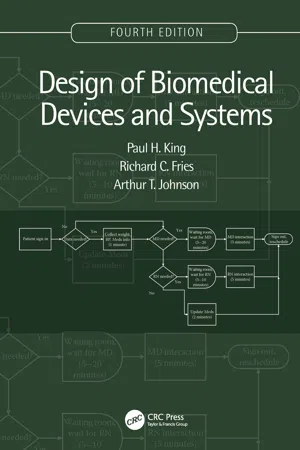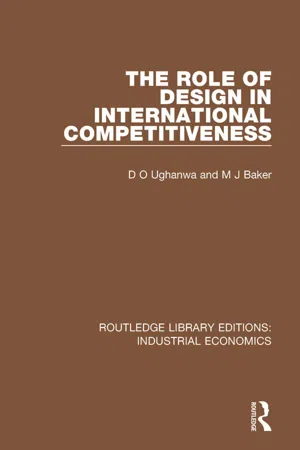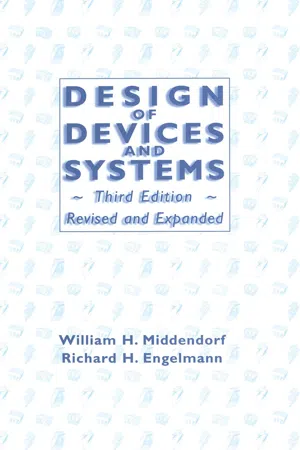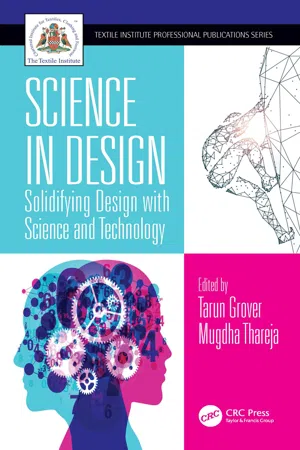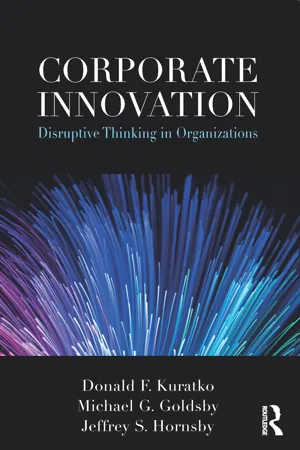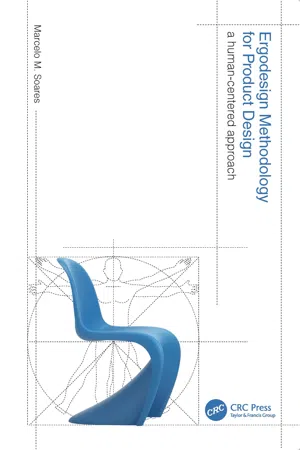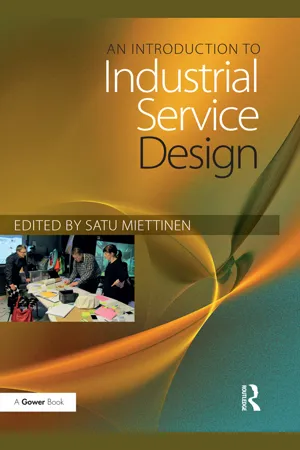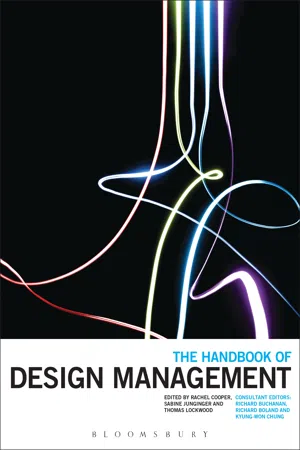Technology & Engineering
Industrial Design
Industrial design involves creating and developing products that are both functional and aesthetically pleasing. It focuses on the design and usability of everyday items, such as furniture, appliances, and consumer electronics. Industrial designers often work to improve the form, ergonomics, and user experience of products, while also considering manufacturing processes and materials.
Written by Perlego with AI-assistance
Related key terms
9 Key excerpts on "Industrial Design"
- Paul H. King, Richard C. Fries, Arthur T. Johnson(Authors)
- 2018(Publication Date)
- CRC Press(Publisher)
The Industrial Designer’s unique contribution places emphasis on those aspects of the product or system that relate most directly to human characteristics, needs, and interests. This contribution requires specialized understanding of visual, tactile, safety, and convenience criteria, with concern for the user. Education and experience in anticipating psychological, physiological, and sociological factors that influence and are perceived by the user are essential Industrial Design resources. Industrial Designers also maintain a practical concern for the following:- Technical processes and requirements for manufacture
- Marketing opportunities and economic constraints
- Distribution sales and servicing processes
In addition to supplying concepts for products and systems, Industrial Designers are often retained for consultation on a variety of problems that have to do with a client’s image. Such assignments include product and organization identity systems, development of communication systems, interior space planning and exhibit design, advertising devices, and packaging and other related services. Their expertise is sought in a wide variety of administrative arenas to assist in developing industrial standards, regulatory guidelines, and quality control procedures to improve manufacturing operations and products. Industrial Designers, as professionals, are guided by their awareness of obligations to fulfill contractual responsibilities to clients, to protect the public safety and well-being, to respect the environment, and to observe ethical business practice.The term Industrial Design- D.O. Ughanwa, M.J. Baker(Authors)
- 2018(Publication Date)
- Routledge(Publisher)
Chapter sixDesign: meaning and applicationIntroductionDesign is the lifeline of modern commercially progressive industries and its role in international competitiveness is growing significantly. Yet confusion seems to exist within and among the design profession as to what design really means and/or the benefits designers can bring to industries. Therefore, the objective of this chapter is twofold. First, it attempts to throw more light on the meaning of design with a view to providing a framework for a better understanding of the design concept as well as to add to the existing knowledge in design studies. Second, it focuses on design as a major contributing factor to non-price competitiveness.The material is divided into five parts. The first reviews the definitions of design and examines the different interpretations attached. Our empirical findings on the innovators’ perception of design is reported.Part two highlights the differences/conflict between two disciplines -- engineering design and Industrial Design (probably introduced by the varying definitions of design). They include gaps in education, status, and product/project presentation. It is concluded that although both disciplines are often perceived as distinct, they are none the less dimensions of the same activity, which calls for a marriage of both disciplines to achieve good results.Consequently, the third part devotes itself to exploring ways of integrating engineering design and Industrial Design. The contributions made by the government and its agents, and a number of individuals towards achieving this objective are critically examined. Our research findings on how the skills embodied within the practice of Industrial Design and engineering design can best be integrated are then reported.It is felt that the technological impact that computers are having on design can facilitate the integration problem, particularly in the area of communication. This is spelled out in the fourth part, which covers discussions on the major computer aids for design (CAD). Next, the results of our survey on the significant changes made by the Queen’s Award winners to their manufacturing processes are presented. It was found that computer-aided design and computer-aided manufacture (CAD/CAM) was the second most frequently used technique, after automation, for introducing change to manufacturing processes by commercially successful firms.- eBook - ePub
- Jens Christensen(Author)
- 2009(Publication Date)
- Aarhus University Press(Publisher)
8. Design Design Design may be defined as applied arts, engineering, architecture, and other such creative activities. 1 Design is a matter of developing and implementing a plan for a creative endeavor that leads normally to a commercial product. It might also include processes that can be seen as the results of design. In its widest sense, every human creation may be considered a product of design, including the making of our societies. In this context, we shall use the term ‘design’ in a more restricted sense that corresponds to a common view of design, namely as the combined aesthetic, functional, and commercial aspects of making an object to be marketed in the market place. Designing normally requires a designer to do the research, thinking, modeling, and adjustment of the object. While engineering is applied design with emphasis on function and the utilization of math, physics and chemistry, the aesthetic perspective of design is dominant in applied arts and architecture. In this context, design is used in the latter sense of the word. More specifically, the term design embraces architecture and interiors, Industrial Design, graphic design, fashion and other applied arts. Fashion will be dealt with separately because of its wide application. Although we stress the importance of design as a creative and aesthetic process, it is always closely related to the materials and production methods applied in the making of the products as well as business considerations. Design is a creative activity but it is also based on a multidisciplinary knowledge that unites in the production process. The History of Design Everything is designed. 2 The world is human made and a result of designing. Today, the engineer, the architect and the designer have made the resources of the world available to us - eBook - ePub
- William H. Middendorf(Author)
- 2017(Publication Date)
- CRC Press(Publisher)
16THE ART OF DESIGN
The main purpose of this book has been to develop various techniques that are useful in design. These techniques may be characterized as engineering techniques or scientific approaches. Design, however, involves a considerable amount of art, that is, a body of knowledge that is acquired principally by experience or by observation and for which no engineering rationale can be advanced. In certain senses it is intuitive in nature.Placing this discussion in the final chapter should not lead you to infer that the art of design is to be considered only toward the end of a product development project. Like reliability and human factors engineering, it should be considered as the development of the product proceeds, entering into the thinking about the design at the beginning. If a final design is so unacceptable that a major redesign is necessary, the changes needed are almost invariably expensive. Moreover, if product evaluation and test results have been used in the original work, all those results are placed in doubt.16.1 DESIGN FOR PRODUCTION
We cannot emphasize too strongly that design is an iterative process. Figure 1.2 , reproduced as Figure 16.1 , illustrates numerous feedback paths that may be used during the design process. It is important to understand that the feedback paths shown are not intended only for the designer. As the design moves forward, designers must avail themselves of the expertise of others within the organization. These include engineers and technicians, especially those with special training or experience in areas different from that of the designer, and appropriate manufacturing, quality control, purchasing, and marketing personnel. As noted earlier, the term that is now frequently used for the interactive relationship just described is concurrent engineering.Figure 16.1 A design procedure.New materials and new manufacturing processes are two of the driving forces in design. This reinforces the comments of the previous paragraph as to the relationship among the designer, manufacturing engineers, sales force, purchasing agents, and others. Productivity begins with the design function and ends with the safe delivery of a reliable product to the consumer. There are many seemingly insignificant design decisions, and most are probably insignificant, especially when considered individually. Some, however, can make a difference between a product that is inexpensive to manufacture and one that is not. As each part is designed, ease of manufacture and ease of assembly should be prime considerations, and ease of installation must not be neglected. - eBook - ePub
Science in Design
Solidifying Design with Science and Technology
- Tarun Grover, Mugdha Thareja(Authors)
- 2020(Publication Date)
- CRC Press(Publisher)
1 General Aspects of Science, Design, and Engineering1.1 What Is Design?
A design is a strategy or specification for the development of a system or object. In other words, design can be thought of as the implementation of a plan or a process to achieve an objective. More often, the term “design” is used to indicate the outcome of a process or strategy in the form of a prototype or a final product. The broader meaning of design can be interpreted more easily with the following narration.Undoubtedly, the term “design” encompasses the varying viewpoints of people who understand its meaning through different lenses. In general, “design” is the process of visualizing and planning the development of systems, objects, methods, products, etc. The definition of design is versatile and artful, and design has taken many shapes and forms based on multidisciplinary concepts. Besides the major cluster of design disciplines (engineering, information systems, industrial, architecture, textile, and fashion), experience design, service design, and interactive design have evolved as new domains for design enthusiasts to explore deeper insights.1.1.1 Definition of Design
First, let’s glance at some of the noteworthy definitions of design by well-known authors.A design is a plan to make something new for people that they perceive as beneficial. – Koss LooijesteijnDesign is a reflective conversation with the materials of a design solution. – Donald A. SchönIt’s the difference between your favourite and least favourite thing you use. – Scott BerkumDesign is its own culture of inquiry and action. – Harold Nelson, Erik StoltermanHaving these in mind, the ability to design and the notion of design relating its associative aspects are the key focus in conceiving the definition of the term “design”. Design can be classified based on three fundamental perspectives: art, problem solving, and the pursuit of the ideal [2 - eBook - ePub
Corporate Innovation
Disruptive Thinking in Organizations
- Donald Kuratko, Michael Goldsby, Jeffrey Hornsby(Authors)
- 2018(Publication Date)
- Routledge(Publisher)
Mechanical engineering is a vital area of new product development. It deals with the design, development, production, control, operation, and service of machines and mechanical devices. Mechanical engineers provide detailed layout and assembly of the components of products and machines. They ensure that the parts of a product fit together and operate as intended. Because of their expertise on components and parts, they can be found in many related areas such as bioengineering, robotics, aerospace engineering, nuclear engineering, ocean engineering, applied mechanics, and manufacturing.Industrial DesignersAlthough not technically an area of engineering, Industrial Design is an area that applies many engineering concepts to designing products. Ergonomics, usability, design-for-manufacturing, and design for end-of-life management are some of the areas involved in Industrial Design. Industrial Designers work to improve the function, value, and appearance of products. Since they focus on the form of the product, they can come from different backgrounds such as architecture, art, and engineering. Industrial Designers such as Sir Jony Ive of Apple and Tinker Hatfield of Nike have garnered worldwide recognition for their products. Their products are admired for their artistic relevance as well as their commercial success. Other aesthetic professionals, such as graphic designers, set designers, and fashion designers, are influencing new product development as well. As prototyping technologies become more accessible in price and availability and design principles propagate through the greater public, we’ll see more companies and innovators implementing the principles of Industrial Design into their products.Understanding the basic roles of the aforementioned engineers will be very useful when you try to develop a product in the future. As you design the function, shape, and components of your product idea, you may need to turn to one of these experts to help you work through design issues. You should be aware that we didn’t provide you with an exhaustive list of engineering categories. Many fields and industries have their own engineering specialists as well, such as nuclear engineering and petroleum engineering. If you’re interested in learning more about engineering and technology, you can obtain free online lectures by visiting the following websites: TED (www.ted.com ), Udacity (www.udacity.com ), the Kahn Academy (www.kahnacademy.org ), MIT’s OpenCourseWare (ocw.mit.edu), and the Stanford Technology Ventures Program (stvp.stanford.edu). For up-to-date information on the latest technologies and science trends, visit www.wired.com , news.cnet.com, www.popsci.com , www.technologyreview.com , and www.popularmechanics.com . The Bureau of Labor Statistics also provides more information on the engineering disciplines at www.bls.gov/ooh/architecture-and-engineering/home.htm - eBook - ePub
Ergodesign Methodology for Product Design
A Human-Centered Approach
- Marcelo M. Soares(Author)
- 2021(Publication Date)
- CRC Press(Publisher)
According to the IEA – International Ergonomics Association (2020), ergonomics can be understood as “the interactions between human beings and other elements of a system and the profession that applies theory, principles, data and methods to design, in order to optimize human well-being and the overall performance of the system”. Note that this official definition of ergonomics uses the term “design” as a project, change, intervention. In this way, Ergonomics is involved in the analysis and design of products and systems of various levels of complexity in order to optimize the interface between the user and the product, the environment and system, be it a toy or an automobile, a control room at an international airport and the equipment, environments, and systems used by its operators.NOTEProduct ergonomics is the area of study which aims systematically to analyze artifacts and their interaction with humans (Soares, 2012). According to the author, it deals with the use of ergonomic methods and tools for the analysis of objects manufactured on an industrial scale and prioritizes the relations of the user, operator, consumer, and those who maintain the product.Ergonomics is a discipline supported by scientific data; product design is the process of creating new and improved products for the use of people and manufacturing aims to convert raw material into manufactured products, thus producing valuable and tradable goods. Ergonomics has clearly strong inputs from science while Product Design is assisted by aesthetic and subjective inputs. Manufacturers, on the other side, are mainly interested in the performance of the product in the market in terms of the quantity of goods sold and the profit made.Usually, the three groups have different approaches. Ergonomists focus mainly on product usability and safety, employing empirical methodologies to achieve this purpose. Product designers endeavor to seek a balance between form, value, and appearance of products, relying on experience, intuition, and creativity to achieve this end. Manufacturers are more pragmatic having to fight for survival in an extremely competitive environment. For a long time that ergonomists have criticized designers for producing unsafe products, failing to emphasize the importance of usability and the lack of scientific reasoning (Grandjean, 1984; Wood, 1990). On the other hand, designers have said that ergonomic data are presented in a format or language unsuitable for designers. They represent an obstruction to design creativity. - eBook - ePub
- Satu Miettinen(Author)
- 2016(Publication Date)
- Routledge(Publisher)
Part IV is about sharing tools for industrial service design.While working on the book, it has become clear that industrial service design faces challenges. Many technology-driven companies are confronting a situation where a competitive advantage is gained based on a good customer-service experience. Industrial service designers are challenged to facilitate cultural and behavioural transformations in technology and engineering-orientated companies, which are changing from technical to human-centred thinking. Industrial companies are required to match production speed with market changes and the changing behaviour of customers. Communication and collaboration within large companies has become difficult. Companies have silos, and departments have individual budgets and strategies, which may conflict. It is hard to manage quality when dealing with the issue of outsourcing from a number of companies. For industrial service designers, this means considerable redesign work to accommodate new technologies, strategies and partners. Effective industrial service design can respond to these challenges.This chapter discusses the findings and conclusions of the authors, and highlights some of the central themes that are relevant to industrial service design.Service design
The aim of service design is to create customer- or human-centred solutions that make the service experience feel logical, desired, competitive and unique for the user, and boost innovation and engagement in companies and institutions while developing and delivering services. Services have become multi-channel. They are experienced and consumed in person, online or in interactions with robots, as in autonomous driving. - eBook - ePub
- Rachel Cooper, Sabine Junginger, Thomas Lockwood, Rachel Cooper, Sabine Junginger, Thomas Lockwood(Authors)
- 2013(Publication Date)
- Bloomsbury Academic(Publisher)
It is widely recognized that the design profession has contributed significantly to corporate assets, including buildings, factories, showrooms, products and corporate identity. Cooper and Press (1995) classified design activities into three distinct sets: the development of corporate identity, the design of saleable products and the design of operating environments. Visual communication design (graphic design) has played a role in improving the quality of corporate communications through advertisements, publications and the Internet, whereas Industrial Design has been influential in enhancing the competitiveness of products and systems. Environmental design has a very strong influence on the value of corporate assets through developing interior and exterior physical environments, to meet day-to-day functional needs or create experiences. Environmental design is typically used as a term to describe environmentally concerned designs linked to issues of sustainability, conservation or the like (as in ‘design for the environment’). However, the term also refers to a group of design disciplines such as interior, display, exhibition, architectural design and others for creating human-designed environment, especially corporate working environment. The use of environmental design in this context is slightly different from ‘systems design’ or the design of complete environment.Along with the enlarged scope of managing design, there have been various attempts to indentify the actual contributions of design in practice. Through a content analysis of more than 700 articles published in DMI’s periodicals over the past two decades, Kim and Chung (2007: 47) discovered that ‘the role of design management has expanded from managing product development into leveraging strategic and competitive advantages, managing identity and brand as strategic assets and maintaining a cutting edge in the global and digital markets.’ Based on their professional experiences, the Design Strategy Group (unpublished interview, 25 August 2005) at Continuum has found that design can connect companies and consumers in a meaningful way by presenting companies with the real voice of the consumers that they act upon, as well as creating competitive advantages by translating business strategies into actionable plans for products and services with superior emotional and experiential value in diverse industries.
Index pages curate the most relevant extracts from our library of academic textbooks. They’ve been created using an in-house natural language model (NLM), each adding context and meaning to key research topics.
